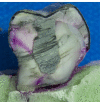In vitro comparison of microleakage with two different techniques of placing stainless steel crowns on mandibular deciduous first molar teeth with decreased mesiodistal width
- PMID: 35936935
- PMCID: PMC9339750
- DOI: 10.34172/joddd.2022.006
In vitro comparison of microleakage with two different techniques of placing stainless steel crowns on mandibular deciduous first molar teeth with decreased mesiodistal width
Abstract
Background. Stainless steel crowns (SSCs) of the opposing maxillary deciduous molar teeth are used in mandibular deciduous first molars with decreased proximal surfaces due to caries. However, the SSCs of maxillary deciduous molar teeth are different from those of the mandibular deciduous molars in terms of the occlusal surface morphology, the buccal margin, and the proximal surface contour. Therefore, it is possible to prepare the buccal and lingual surfaces to use the SSC of the lower deciduous molar teeth and compare microleakage. Methods. Eighty extracted mandibular deciduous first molars were randomly assigned to two groups. In the case group (BLP), the buccal (B) and lingual (L) surfaces were prepared in addition to the proximal (P) surface, and an SSC was placed on the mandibular first deciduous teeth. Only the proximal surface was prepared in the control (P) group, and the SSC of the opposing tooth (maxillary deciduous first molar teeth) was placed. After dissecting the teeth, the extent of dye penetration was measured. Results. The difference in microleakage on the buccal aspect between the case and control groups was significant (P=0.02); however, the difference in microleakage on the lingual aspect between the case and control groups was not significant (P=0.89). Conclusion. Microleakage at the buccal margin of the SSC of mandibular deciduous first molars was less than the maxillary deciduous first molar SSC, with no significant differences in the lingual margin.
Keywords: Crown; Deciduous teeth; Leakage; Stainless steel drown.
©2022 The Author(s).
Similar articles
-
Effect of tooth preparation on microleakage of stainless steel crowns placed on primary mandibular first molars with reduced mesiodistal dimension.J Dent (Tehran). 2015 Jan;12(1):18-24. J Dent (Tehran). 2015. PMID: 26005450 Free PMC article.
-
Microleakage of stainless steel crowns placed on intact and extensively destroyed primary first molars: an in vitro study.Pediatr Dent. 2011 Nov-Dec;33(7):525-8. Pediatr Dent. 2011. PMID: 22353415
-
Comparison of the morphology of the primary first molars and the forms of stainless steel crowns used in clinical practice.J Clin Pediatr Dent. 2023 May;47(3):71-83. doi: 10.22514/jocpd.2023.025. Epub 2023 May 3. J Clin Pediatr Dent. 2023. PMID: 37143424
-
The use of stainless steel crowns.Pediatr Dent. 2002 Sep-Oct;24(5):501-5. Pediatr Dent. 2002. PMID: 12412965 Review.
-
Preformed posterior stainless steel crowns: an update.Compend Contin Educ Dent. 1999 Feb;20(2):89-92, 94-6, 98-100 passim; quiz 106. Compend Contin Educ Dent. 1999. PMID: 11692330 Review.
References
-
- Memarpour M, Mesbahi M, Rezvani G, Rahimi M. Microleakage of adhesive and nonadhesive luting cements for stainless steel crowns. Pediatr Dent. 2011;33(7):501–4. - PubMed
-
- Seraj B, Shahrabi M, Motahari P, Ahmadi R, Ghadimi S, Mosharafian S, et al. Microleakage of stainless steel crowns placed on intact and extensively destroyed primary first molars: an in vitro study. Pediatr Dent. 2011;33(7):525–8. - PubMed
-
- Tote J, Gadhane A, Das G, Soni S, Jaiswal K, Vidhale G. Posterior Esthetic Crowns in Peadiatric Dentistry. Int J Dent Med Res. 2015;1(6):197–201.
LinkOut - more resources
Full Text Sources


